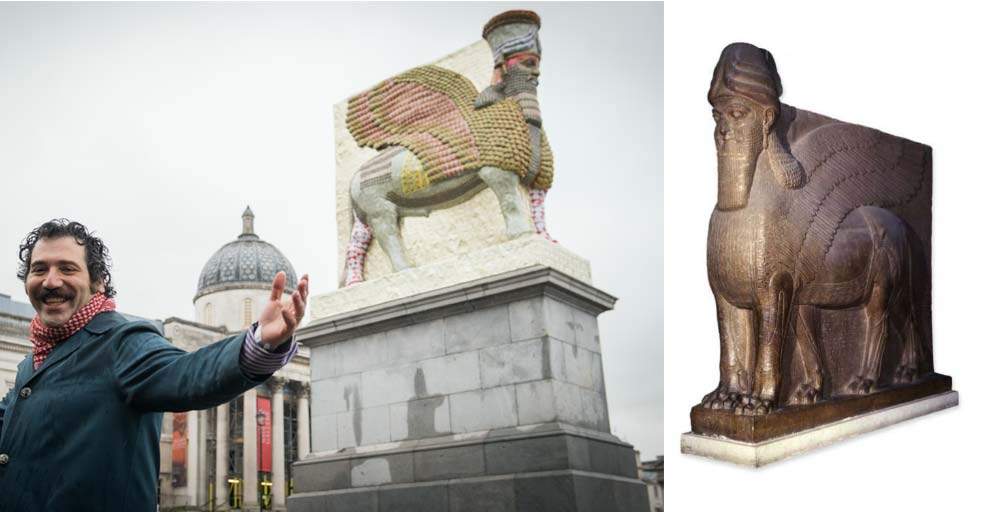Iraqi-American sculptor Michael Rakowitz (Long Island, 1973) sent a letter to the British Museum proposing that the London museum return one of its Assyrian treasures, one of two winged lamassu bulls in the museum’s collections, in exchange for one of his works, a contemporary reinterpretation of the Assyrian bull installed on the empty pedestal in Trafalgar Square from 2018 to 2020. The British sculpture, a human-headed winged bull from the 9th century B.C., was discovered in Nineveh in Victorian times by British archaeologist Austen Henry Layard, and entered the London museum’s collection in 1851.
Recounting Rakowitz’s proposal is the Guardian: according to the artist, the return of the lamassu would serve to replace a lamassu from around 700 B.C., which was located at the Nergal Gate in Nineveh, left in place by Layard in the 1800s but deliberately destroyed by Isis in the raid on the Mosul Museum in 2015. Rakowitz’s proposal, the Guardian reveals, is expected to be discussed during a visit to London next month by Iraq’s new culture minister, Ahmed Fakkak, when he is expected to be offered a tour of the British Museum.
“As I reflected on my gift to the nation of Great Britain,” Rakowitz writes in his letter, "I began to fantasize that it might be connected to a second gift: the return of one of the British’s lamassu to the Museum of Iraq, to replace what was destroyed by Daesh.“ ”Given all that has been destroyed in Iraq, and given that that destruction pairs with the West’s insatiable appetite for Oriental objects,“ the letter continues, ”while not always, if ever, this concern is extended to the people of those places, this return of an original would be more than just a return. It would be regenerative.“ Rakowitz said the British Museum initially rejected the idea when he first suggested it in 2020. He was told that the museum had helped produce replicas of the originals. Rakowitz said, ”I thought to myself, this is fucking crazy. Where is the dignity in sending back things that are basically a shell of the original?"
However, the artist added that other museum experts have been more understanding. “I have had a generally good relationship with some of the people at the British Museum, who do not echo the general attitude that things cannot go back. The discussions and requests are about breaking down some of the language that protects these objects and institutions.” Rakowitz said the Tate Modern was lobbying behind the scenes to try to make his dream come true. He said, “The Tate agreed informally that they would lobby the British Museum to return the lamassu. The Tate leadership was very much in tune with that goal.”
On the Iraqi side, the Asian country would be eager to see the ancient lamassu returned. But it is currently unknown whether Minister Fakkak will press for the sculpture to be returned to Iraq. And the British currently has not committed to anything concrete, although it has not ruled out loans, the Guardian reports.
Pictured: left, Michael Rakowitz with his work; right, the British’s lamassu .
 |
| Artist asks British Museum to return Assyrian treasure to Iraq in exchange for one of his works |
Warning: the translation into English of the original Italian article was created using automatic tools. We undertake to review all articles, but we do not guarantee the total absence of inaccuracies in the translation due to the program. You can find the original by clicking on the ITA button. If you find any mistake,please contact us.